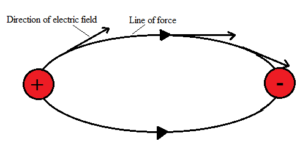Science > Physics > Electrostatics > The Concept of Electric Field
When a charge is kept in a medium it sets around it, what is called an electric field. It can be represented by drawing what is called lines of force. If another charge is brought into this region it experiences a force. Due to the field, the charges experience the force of attraction or repulsion. The region around a charge or system of charges within which other charged particles experience an electrostatic force is called an electric field.
Lines of Force and Line of Induction:
The electric field can be represented by drawing what is called the lines of force. They can be straight or curved. A line of force is a locus of all the points through which a free unit positive charge (test charge) will move when kept in the field. If the medium is other than air or vacuum, the lines of force are called lines of induction.
The direction of the electrical field at a point can be obtained by drawing a tangent to the line of force passing through that point.

Characteristics of Electric Lines of Force:
- Lines of force are imaginary lines or hypothetical lines.
- Lines of force always emerge out from a positive charge and terminate on a negative charge. Thus the lines of force coming out from positive charge are supposed to end at a negative induced charge on the surrounding and the lines of force coming towards negative charge are supposed to start from a positive induced charge on the surrounding.

In the following photograph a student with long hair is touching electrode of Van de Graaff generator, we can see that the hair follow electric lines of force.

- Lines of force always emerge out or terminate at right angles to the surface (normally).
- When two similar charges are kept near to each other the lines of force push each other and thus there is repulsion between the two similar charges.

- When two dissimilar charges are kept near to each other the lines of force will try to come near to each other and hence there is an attraction between two dissimilar charges. The lines of force start from a positive charge and end on a negative charge. So the lines of force do not form closed loops.

- The lines of force exert a lateral force on each other. i.e. they try to repel each other. This explains repulsion between two like charges.
- The lines of force possess a longitudinal tension hence they have a tendency to shrink i.e. to contract lengthwise. This explains the attraction between unlike charges.
- Lines of force never intersect with each other. If they do so, it means that at the point of intersection of the two lines the electric field has two directions which is not possible. Having two directions means the test charge at that point can move in two different directions simultaneously.
- It is possible for us to draw lines of force through each and every point in the medium. But it will result in overcrowding of the lines. And thus it is not possible for us to study them. Hence lines of forces are grouped into what is called ‘tubes of force.
- If the tubes of force are crowded together then the field is strong.
- If the tubes are equally spaced then the field is uniform.
Types of Electric Field:
Uniform Electric Field:
When magnitude and direction of electric intensity are the same at all the points in the electric field, then it is called a uniform electric field. It is represented by drawing equidistant parallel straight lines in the direction of the field.

Non-Uniform Electric Field:
When magnitude and direction of electric intensity are not the same at all the points in the electric field, then it is called a non-uniform electric field.

Radial Electric Field:
When electric intensity E at any point in the electric field is directed towards or away from the same fixed point, then the field is called a radial electric field.

Electric Field Intensity:
Electric intensity at a point in an electric field is defined as the force acting on a unit positive charge when placed at that point.
It is denoted by the letter ‘E’ and its S.I. unit is N/C or V/m. Mathematically

Electric intensity at a point gives us the idea of the strength of the electric field at that point. Stronger the field at a point greater is the magnitude of the electric intensity.
Electric intensity is a vector quantity and its direction at a point is the same as the direction of force acting on positive test charge kept at that point.
Expression for Electric Intensity at a Point Due to Point Charge:
Consider a charge ‘q’ a placed at point O as shown. Let P be the point at a distance of ‘r’ from O where electric intensity is to be found.

Let us consider a positive charge qo kept at point P. The force acting on qo, due to q is given by Coulombs Law.

By definition of Electric Intensity,

This is an expression for electric intensity at a point at a distance of ‘r’ from a point charge. The direction of electric intensity is the same as that of force at that point.
The Expression for Electric Intensity in a Vector Form:
